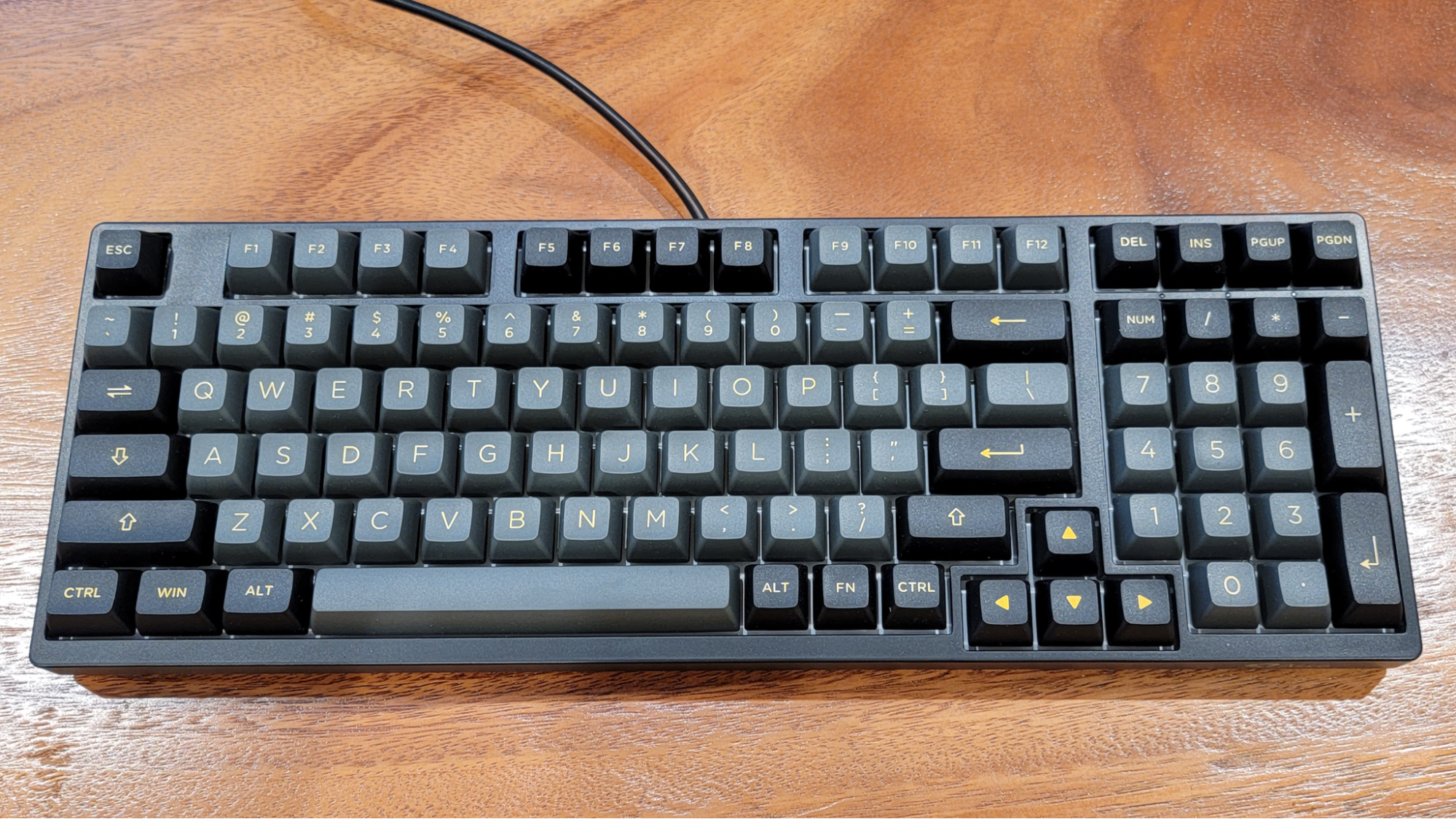Tom's Hardware Verdict
An impressive productivity keyboard with gaming prowess, the Akko 3098B / N combines a first-class typing experience with classic good looks, a compact 96-percent layout and plenty of wireless functionality.
Pros
- +
+ Classy Design
- +
+ Fantastic ASA Keycaps
- +
+ Hot-Swappable Switches
- +
+ 2.4-GHz, Bluetooth and Wired Connectivity
- +
+ Long battery life
- +
+ Multi-level flip-out feet
Cons
- -
Default switches lack clicky option
- -
Software issues
- -
RGB Could Be More Customizable
- -
No switch puller included despite hot swappable switches
Why you can trust Tom's Hardware
Your keyboard is the part of your workstation that you interact with the most, so getting a better one can change how you experience your computer. Akko’s 3098B and 3098N are just the kind of devices that can take your productivity and gaming response to another level of comfort and efficiency. Starting at $109, these keyboards -- identical but for the model of controller chip inside of them -- offer a smorgasbord of key features including: terminal-style SA keycaps, hot-swappable switches, colorful RGB backlighting and the ability to connect via Bluetooth, 2.4-GHz or USB-C.
Perhaps more importantly, the compact 96-percent design and deep curve of the keycaps make for a first-class typing experience. However, if you don’t like linear switches, you may want to swap in some of your own.
Akko 3098B / N Specs
| Switches | Akko CS Jelly White, CS Jelly Pink, CS Jelly Blue (3098B) or Akko TTC Silent Red V3 Switches or TTC Princess switches (3098N) |
| Lighting | Per-key RGB |
| Media Keys | No |
| Connectivity | 2.4 GHz USB Type-A dongle, Bluetooth 5.0 (up to 4 profiles), wired |
| Cable | USB Type-A to USB Type-C, braided, detachable |
| Additional Ports | None |
| Key Caps | PBT SA Keycaps |
| Construction | Aluminum top plate, plastic base |
| Software | Akko Cloud Driver |
| Dimensions (LxWxH) | 17.7 x 9.8 x 1.7 inches (450.7 x 248.4 x 42.3mm) |
| Weight | 2.4 pounds (1.1 kg) |
Design and Layout of the Akko 3098B / N
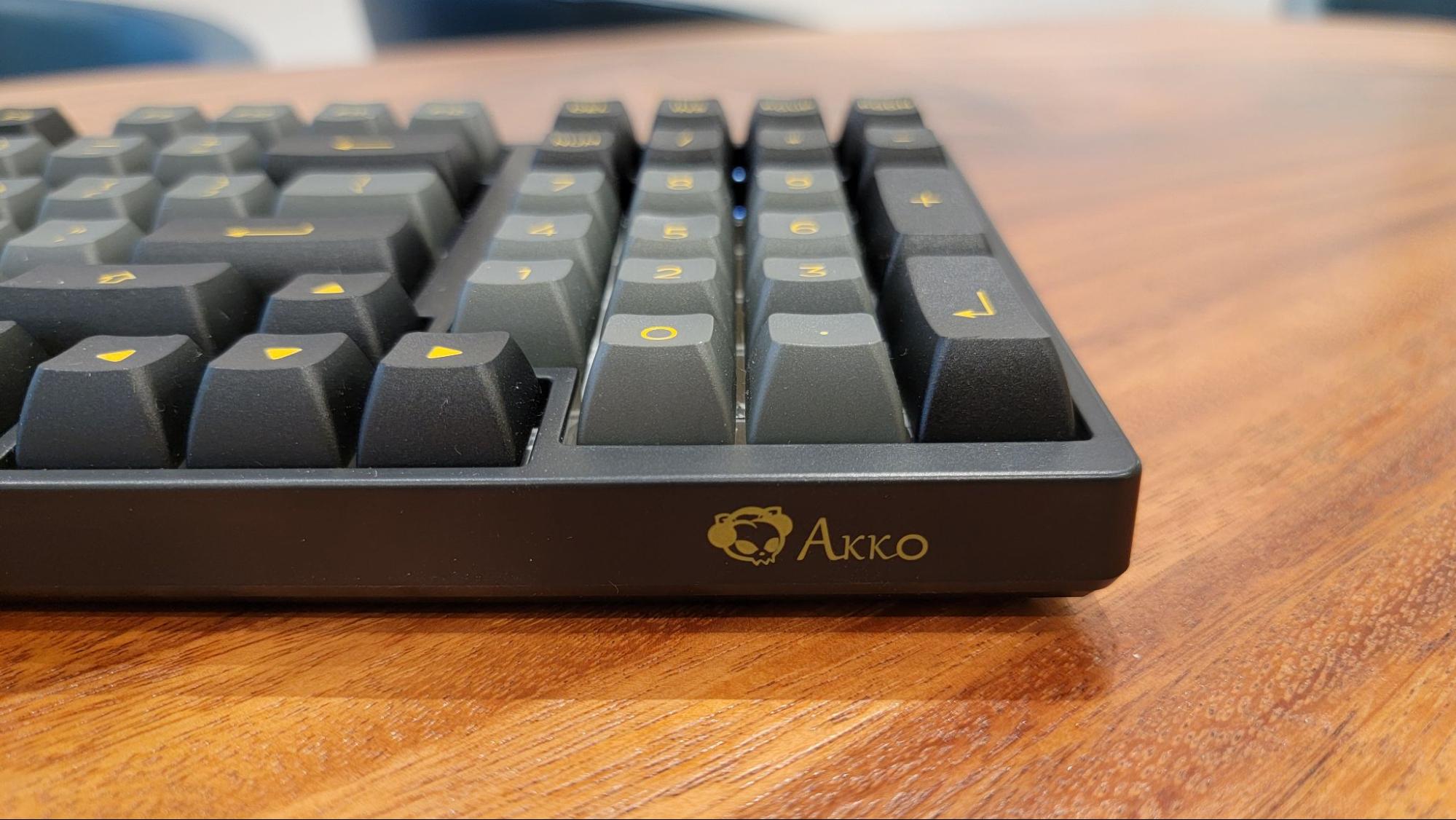
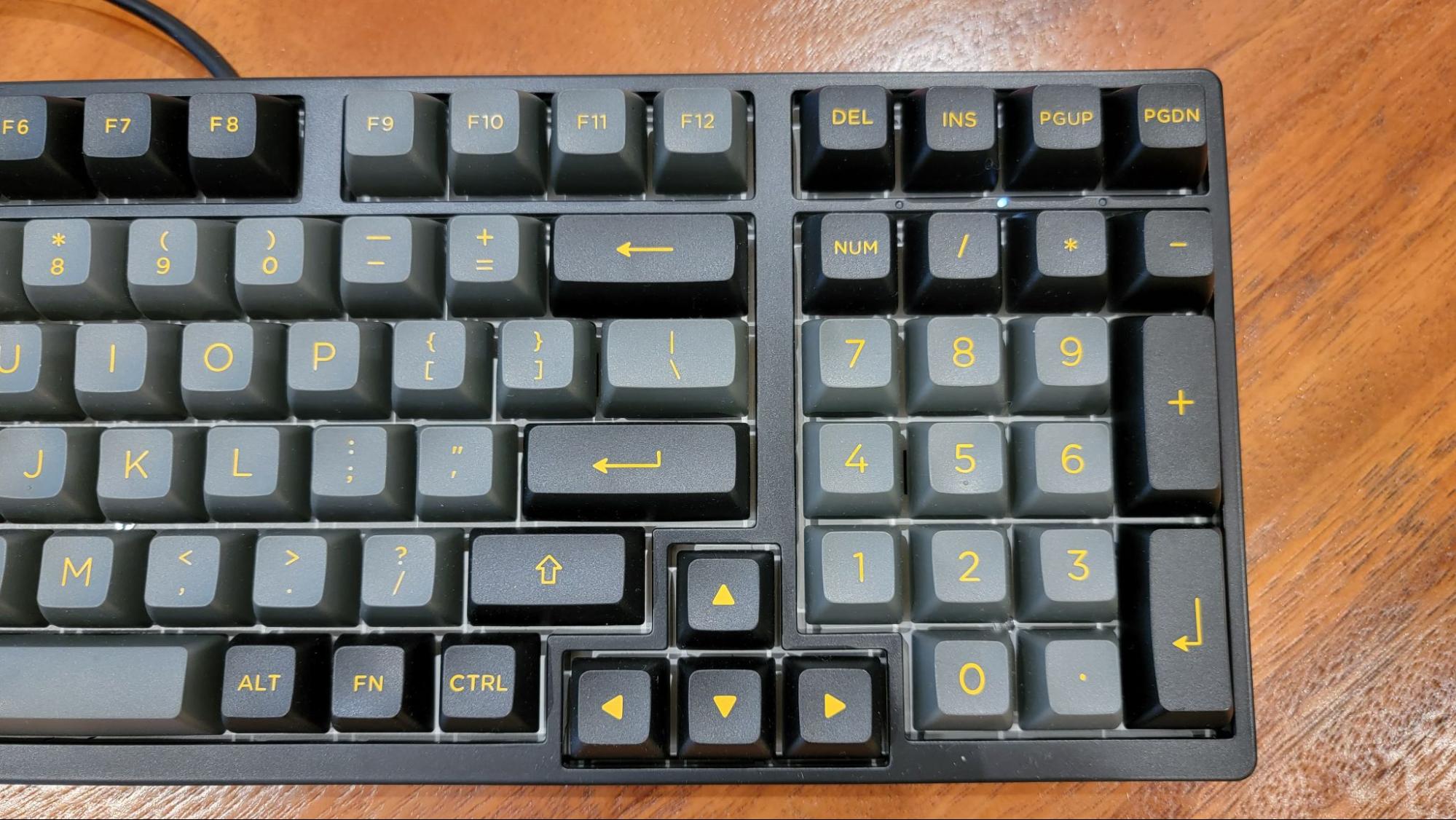
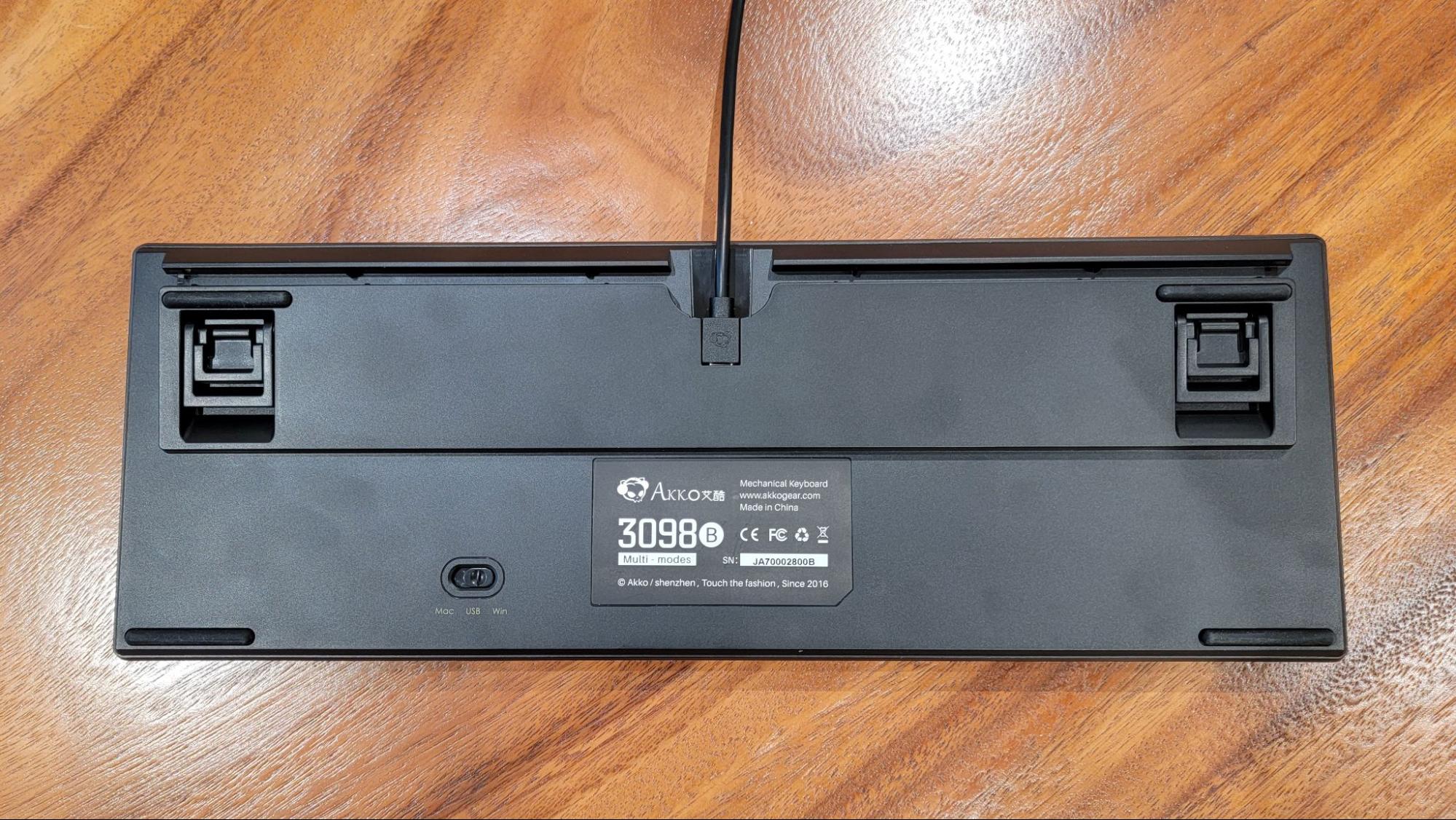
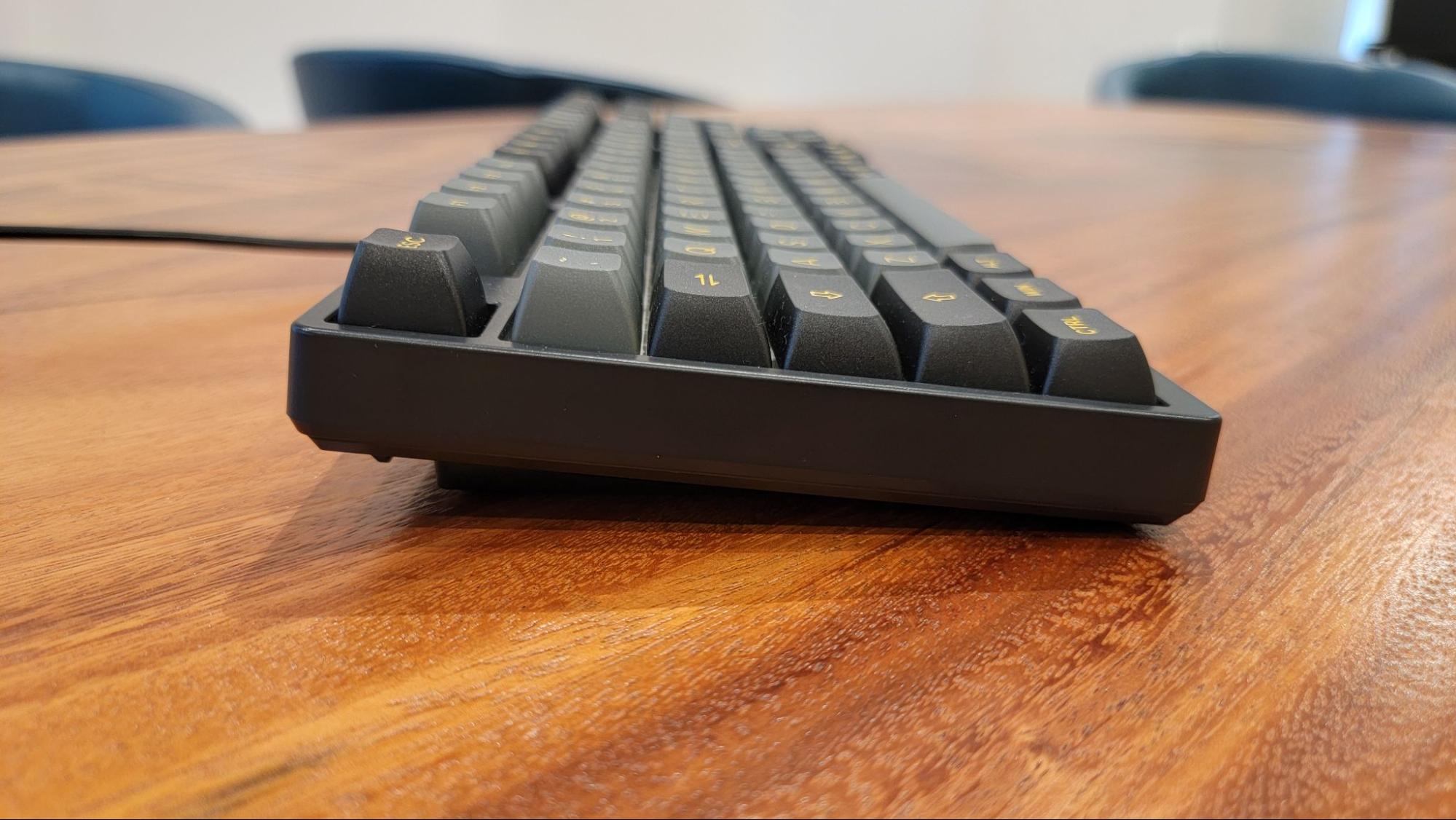
The Akko 3098 series is an incredibly handsome device that, in the Black and Gold color scheme we tested, is professional enough for the most conservative office environment while offering the kind of retro design flourishes that a serious mechanical keyboard fan will fall in love with. Sitting at my four-monitor workstation with this terminal-like keyboard made me feel like Hugh Jackman’s master hacker character in Swordfish.
The matte black plastic chassis has an extremely premium feel and, at 2.4 pounds (1.1kg), has enough heft to make it feel as sturdy as a tank. There was not a hint of flex or creaking on this chassis, even when we tried to squeeze it. Noise dampening foam prevents any kind of rattle.
The 96-percent layout strikes a perfect balance between saving desk space and having just about every key you could want. At 15 x 5.3 inches (382 x 134mm), the Akko 3098 is significantly narrower than the Hexgears Impulse (17.3 x 6 inches), which is one of the most compact full-size keyboards on the market and looks even slimmer in comparison to the top-rated Patriot Viper V765 (18.4 x 6.4 inches). The Corsair K70 RGB TKL, our favorite tenkeyless keyboard, is only 0.8 inches narrower than the 3098.
The keyboard gives you not one, but two different sets of flip-out feet so you can adjust the height to your liking. With all feet retracted, the rear of the Akko 3098 is raised about 30mm off your desk. That height goes up another 10mm with the shorter feet active and yet another 10mm (a total of about 50mm) with the longest feet extended. I found the height and angle with the smaller feet ideal.
In addition to the feet, the bottom has a recessed space for the USB-C port, which works with both the included wire or any other USB-C cable you have lying around. There’s also a toggle switch which allows you to choose between USB mode, wireless Windows mode and Mac mode (for Mac layouts). The only real design flaw here is that there’s no place to store the 2.4-GHz wireless dongle that comes with the Akko 3098, so be careful not to lose it.
Akko achieves its svelte form factor by pushing the arrow key block much closer to the Left Shift and Enter keys, doing away with the 9-key block with Home / End / Insert / Delete that usually sits above the arrow block, and adding another 4-key row above the numpad. However, you do lose a few keys in the process, including the ever-important Prtscr key and the dedicated Home / End keys, but you can always replicate these with 7 and 1 on the numpad.
I quickly learned that hitting Fn + P invokes the print screen function, but I still missed having a dedicated print screen key. Akko doesn’t provide a built-in way to remap your keys, but other programs such as Sharpkeys provide ways to do that. I would definitely trade the Insert key, which I never use, for Prtscr.
ASA Keycaps on Akko 3098B / N
Akko’s own ASA-style, PBT keycaps are the star of the show, providing the curved shape and large fonts you might find on an old-fashioned mainframe keyboard, but without the elevated height of SA keycaps, which some typists find a little too hard to press. The keys are a mixture of black and dark gray but with bright gold legends,many of which are spelled out in a retro style. For example, instead of a Windows key with the Windows logo on it, the legend says “WIN” in all caps. Other keys like ALT and CTRL are in all caps too, which is reminiscent of terminal keyboards.
The Akko 3098 also comes with a set of 20 alternate keycaps that are gold with black legends on them. These include a spacebar, backspace, enter and shift keys, along with function keys, arrows, Esc and a few keys that have cute drawings on them such as a flower or a cat’s paw. There’s even a key with a legend that reads “PS,” which I would use if I remapped the Insert key into Prtscr.
If you don’t buy the Akko 3098 and just want the keycaps, the company sells them separately for $59. So, if you consider that part of the price, you’re paying a miniscule $50 to $70 for the rest of the keyboard.
Configurations of the Akko 3098
The Akko 3098 comes in a wide variety of color schemes and three major model names. The 3098 regular is the wired-only version and typically goes for less than $90, depending on the keycaps and color. The 3098B and 3098N, both of which we tested, provide three means of connectivity: Bluetooth, 2.4 GHz wireless and wired.
The differences between the B and N models are very minor and not apparent just from looking at the keyboard. The 3098B, priced at $109, uses a Beken brand controller chip which provides brighter RGB backlights and purportedly uses a little more power than the Nordic brand chip in the $129 3098N. The Beken can use either Bluetooth 3.0 or Bluetooth 5.0 to provide up to three Bluetooth profiles while the Nordic only uses Bluetooth 5.0 only to support up to four profiles. The Nordic chip allows you to program macros directly onto the keyboard without software (more on that later) while the Beken cannot.
Key Switches on the Akko 3098B / N
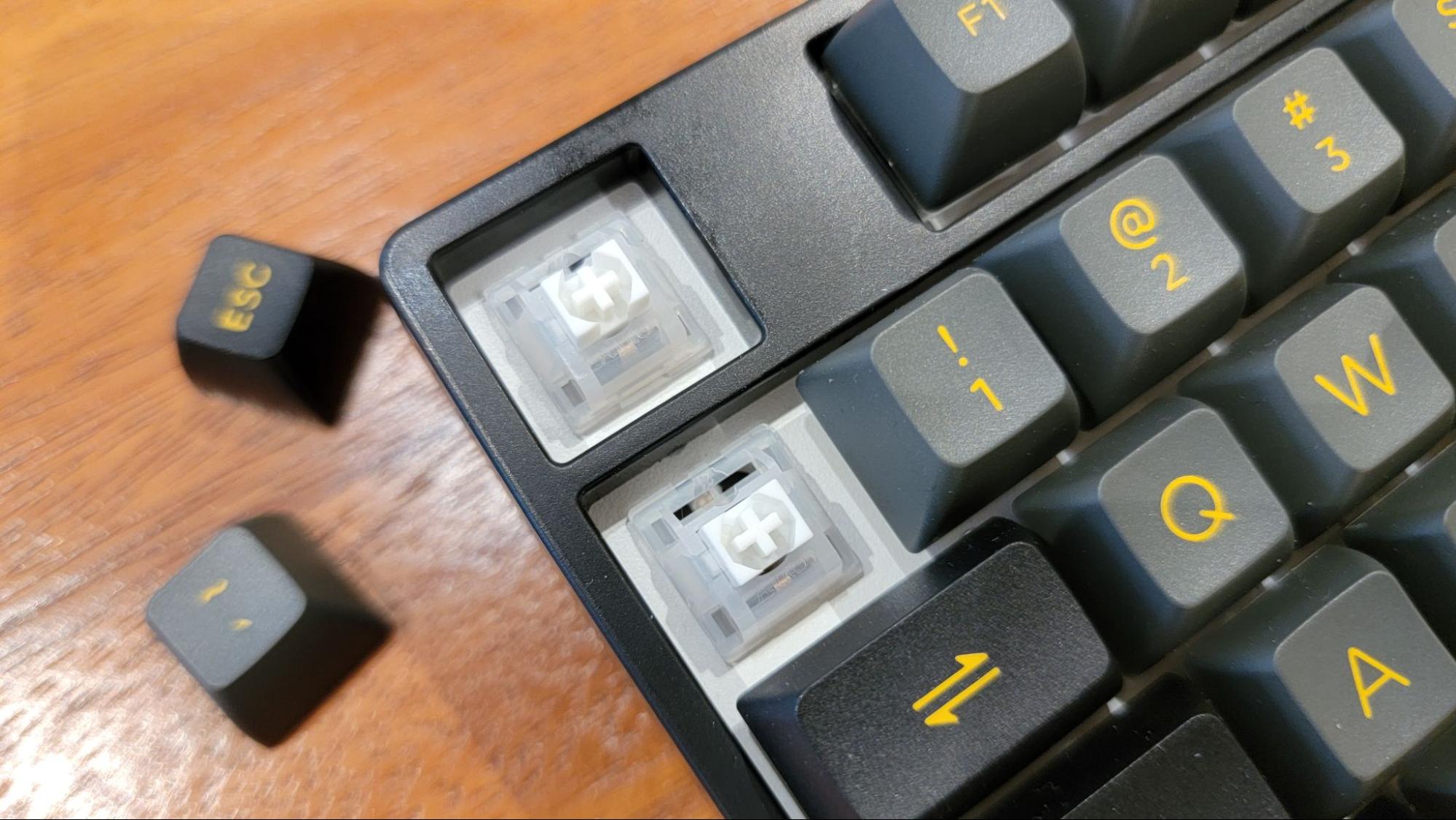
A bigger difference between the Akko 3098B and the 3098N is the switch selection. The 3098B comes with a choice of either Akko CS Jelly White, CS Jelly Pink or CS Jelly Blue switches while the 3098N has Akko TTC Silent Red V3 Switches or TTC Princess switches.
If you don’t like linear switches, you’ll want to take advantage of the 3098’s hot-swapping capability to install ones you like. Though you get a choice of switches when you buy the keyboard, most of them are linear and I didn’t see any clicky options available.
I tested a 3098B with Akko CS Jelly White switches and a 3098N with the TTC Silent Reds. Though I am huge clicky-switch fan and generally dislike linear switches, I really enjoyed typing on the CS Jelly White switches; they made a pleasant sound on the way down and had as much of a tactile feel as I’ve ever experienced from linears. The company says its Jelly White’s require only 35 grams of actuation force with 4mm of travel and 1.9mm of pre-travel.
The TTC Silent Red switches, on the other hand, were extremely unpleasant to use as hitting them felt like pushing down hard against a cardboard box and, after using them for just a few minutes, I couldn’t wait to hot-swap them out for something better. They are specced for 45 grams of actuation force and 4mm of total travel.
Hot-Swapping on the Akko 3098B / N
If you are a clicky aficionado like I am, you can still get a ton out of the Akko 3098B / N; you just have to swap out the switches. Akko makes it easy for you, because the switches are hot-swappable and the sockets support either 3 or 5-pin switches. The only real problem is that the keyboard doesn’t come with a switch puller so, if you don’t have one, you’ll need to buy one. On the bright side, there’s a very competent keycap puller in the box.
To test the hot-swapping experience, I pulled all the TTC Silent Red switches out of the 3098N and replaced them with some Kailh Box White clicky switches, my favorites, that I had in the house. Removing the switches wasn’t difficult; it just required a little elbow grease as I used my puller to wiggle them until they dislodged. Popping in my new switches required a little precision because a few times I bent the pins on a switch by not lining it up properly. However, these issues are the same as I’ve experienced on other hot-swappable keyboards.
After an hour or so of work, I ended up with a dream keyboard: one that combined the wonderful, curved terminal feel of ASA keycaps with the snappy, tactile feedback of Kailh Box White switches and a compact but generous 96-percent layout. It would be ideal if Akko offered the 3098 with a clicky-switch option, but since the company only uses its own TTC and Jelly-branded switches, many folks would still want to bring their own. Considering the very affordable price of the 3098B ($109), it’s not too much of a stretch to also buy switches.
Typing Experience on the Akko 3098B / N
I found typing on both the Akko 3098B, with its default CS Jelly White switches, and 3098N, with my Kailh Box Whites, thrilling. Normally, I’d say that typing on a great keyboard is a pleasure or a joy, but I’ll use the word “thrilling” here, because thanks to the curved, retro-style keys and the auditory feedback I got, I felt like I was typing like people do in blockbuster movies.
WIth the loud clack of the linear CS Jelly White switches and their tactile feel, I felt like I was Matthew Broderick hacking into WOPR in War Games on his old-school IMSAI 8080 computer. I’ve never liked linear switches, but these CS Jelly Whites give just enough of a tactile feel and make such a great sound that I really like typing on them. On the 10 Fast Fingers typing test, I was able to achieve a speed of 105 words per minute, with less than a 5-percent error rate, which is really good for me and above my typical 95 to 100 wpm.
The default TTC Silent Red switches on the Akko 3098N were so bad that I didn’t even attempt a typing test on them. Pressing down on each switch seemed to require a ton of force and the keys were stiffer than even the worst rubber dome keyboards I’ve used.
However, using my Kailh Box White switches on the 3098N took my typing experience to a whole other level. Combining the great indentations on the SA keycaps with the sharp springiness of the switches made me feel like I was sitting in the newsroom of the Daily Planet, banging out a breaking news story at breakneck speed. The keys felt like an extension of my fingers as I hit a strong 114 words per minute with a low 2-percent error rate.
Gaming Experience on Akko 3098B / N
In its instruction manuals, Akko claims that both the 3098B and 3098N have N-Key rollover. Using an online test, I found that the keyboard is able to report at least 10 keys at a time.
In anecdotal testing, the keyboard was more than adequate for gaming. When I fired up a session of Cyberpunk 2077, I had no problem running around in a gun fight and didn’t notice any lag when connecting over 2.4 GHz wireless. I found that, perhaps unsurprisingly, the linear Jelly White switches on the 3098B were better for quick presses than the clicky switches I hot-swapped into the 3098N.
Bluetooth and 2.4-GHz Wireless on Akko 3098B / N
Both the Akko 3098B and 3098N offer a combination of 2.4 GHz, Bluetooth and wired USB connections. The 3098B supports three different Bluetooth profiles and can accommodate Bluetooth 3.0 or 5.0 connections while the 3098N has four profiles that use Bluetooth 5.0. Both models come with 2.4GHz dongles and long USB-C to A cables. I was also able to use my own USB-C cables as a substitute.
All modes worked well and I was particularly impressed with how quickly and easily I could switch among them. On the 3098B, moving from mode to mode was as simple as hitting Fn + E, R or T for Bluetooth profiles, Fn + Y for 2.4-Ghz or Fn + U for wired. The 3098N uses Fn + number 1 to 6 for its four Bluetooth profiles, 2.4-Ghz and wireless modes. It would be more helpful if these shortcuts were labeled but would probably mess with the aesthetic.
Pairing via Bluetooth was pretty seamless, but since this is Bluetooth, there were a couple of brief frustrations during pairing. I found that the 3098N would not Bluetooth pair with my Windows PC until I had deleted the wired profile for the keyboard. And the first time I attempted to pair the 3098B with a Raspberry Pi 4, it somehow tried to pair as Bluetooth 3 and didn’t connect until I deleted and paired again (this time it appeared as Bluetooth 5.0).
However, after that, connecting and reconnecting was a breeze. It took a second or less to switch from one connection to another, allowing me to use one keyboard with both my Pi and my PC at the same time. If you include all five or six connections, you could easily control that many devices from one keyboard.
A three-setting switch also sits on the bottom of each keyboard, allowing you to choose from Windows, Mac or USB modes. It’s important to note, though, that putting the switch on USB, the middle setting, doesn’t actually put the keyboard into USB connectivity mode; it just effectively turns off charging. You still need to select wired or wireless modes using the Fn key.
Battery Life of the Akko 3098B / N
Akko claims that the 3098B uses more power than the 3098N, with the former rated for 14 to 20 hours of wireless use while the latter is rated for 30 to 40 hours. With anecdotal testing, it’s hard to say how accurate those numbers are. I used the 3098N, with RGB enabled, for two to three really long days in a row on 2.4-GHz wireless before it needed a recharge. I didn’t use the 3098B in wireless mode for nearly as long but did, at one point, need to charge it.
RGB Lighting on Akko 3098B / N
While the RGB backlights are a little bit brighter on 3098B than the 3098N, both models offer vibrant colors and a wide variety of more than 20 animations, from the traditional “breathing” and “wave” effects you see on almost every keyboard to “Laster,” which shoots an animation rightward from whatever key you press. Note that the keycaps are not translucent so the light goes around them, but not through them as you’d see on many gaming keyboards.
Overall, the Akko 3098 comes with 20 different lighting effects built in and the ability to do per-key lighting via software. Toggling among the effects is as easy as hitting Fn + Del, Ins, PgUp or PgDn as each of these keys has five effects assigned to it. You can slow down or speed up the effects by hitting Fn and + or -, adjust the brightness with Fn + up or down arrow, change the direction of an animation by hitting Fn + left or right arrow or change from RGB to a single color by hitting Fn + \.
If you download and install the Akko Cloud Driver software, you can view and select all these effects from a pull down menu and you can configure per-key lighting. There are also two “Music Follow” profiles that make your keyboard’s lights flash in time to whatever you’re listening to. When I put on AC/DC’s “Hell’s Bells,” I could see the lights moving to match the ringing bell at the beginning and then the pumping drums and guitar licks. Note that you need to be plugged in to use the software and for this to work.
Built-in Macro Functions of the Akko 3098B / N
While many keyboards come with built-in macro functions or software that enables macros, you can almost always get a better experience by using free, third-party macro software such as AutoHotKey, my personal favorite, or Clavier+. Akko provides the ability to create macros and save them directly to the 3098’s memory, which means that they will run even if you connect to a computer that doesn’t have the keyboard’s software installed. In my experience, though, the benefits weren’t worth the hassle.
The Akko 3098B sets up its macros via the Akko Cloud software. First you go into the Macro tab, click a button to create a new macro, hit the Start button there to record, enter your keystrokes and hit stop. You can edit the list of keys and the delays between each press after you are done recording. Then you can navigate to the main tab which contains a key map and you can select the key or key + fn combo you wish to assign the macro to. You can use this same menu to remap keys, which I did, turning the / key on the numpad into the Prtscr key.
Unfortunately, I couldn’t get the assigned macros on the 3098B to work properly. When I created a macro that was supposed to type “tomshardware.com,” and assigned it to a key, at first all I got was the letter “t.” Then I tried to shorten the delays between each key press in the phrase and the next time I invoked the macro, the keyboard went crazy, rapidly retyping tomshardware.com and then repeating the letter “m” at the end over and over again without stopping until I pulled the plug.
On the Akko 3098N, unlike with the 3098B, you can program macros without installing any software. By using a series of key combinations, you can put the keyboard into record mode, record your action and then assign it to a key combo. I was able to create a macro successfully on the 3098N using this process, but since there’s no UI to edit or even view your macros, it’s not very convenient.
Software on Akko 3098B / N
You can access most of the functions of either the 3098B or 3098N without installing any software, but Akko does have a couple of apps you can download on its website. For the 3098B, there’s a utility called Akko Cloud Driver, which I used to customize the lighting, remap keys and attempt to set macros (with issues). You can also use this utility to check for firmware updates.
The 3098N allows you to set macros without software, but if you want to customize the RGB lighting or check for firmware updates you’ll need to download the “3098N Firmware & Driver” zip file from Akko’s site. Unfortunately, this zip file was flagged by both Windows Defender and Avast antivirus as having an unknown virus so I didn’t try installing any of the software inside.
It remains unclear whether the 3098N Firmware & Driver download is actually infected or if it is triggering a false positive on two different apps. However, I wasn’t about to take the risk of installing it. I sent a note to Akko’s PR asking about this problem and will update this review if I receive a response. On the bright side, you really don’t need the software for the 3098N, unless you want to set custom per-key lighting or use the Music Following lighting effect, which is a gimmick you’ll probably get bored of after five minutes.
Bottom Line

In the course of testing for this review, I spent a month using the Akko 3098B (Jelly White switches) as my everyday keyboard at the office and the Akko 3098N (with switches swapped for Kailh Box Whites) as my daily driver at home. I fell in love with this keyboard’s snazzy design, fantastic build quality, compact layout and, best-of-all, world-class typing experience. During my toughest days of the year -- working 18-hour shifts on Black Friday weekend -- the keyboard was my tool of choice and it made my job more pleasant.
The SA style keycaps, themselves worth $60, really made the experience as the deep curves cradled my fingers for an extra-tactile experience. The refined look of the Black & Gold color scheme makes it the perfect look for grown-ups, classy-enough for a conservative office space but, like a James Bond tuxedo with a bright gold bowtie, full of flare with the option for an RGB party in the backlight. The build quality of the keyboard belies its affordable price, providing a rock-solid, rattle-free chassis with two-levels of height adjustment. And the 96-percent layout is perfect not only for saving desk space but also for fitting on your lap.
If the Akko 3098B and 3098N were wired-only keyboards, they’d still be a top choice for typing and gaming. However, the 2.4-GHz wireless and Bluetooth capabilities provide a significant helping of gravy on this already scrumptious feast, particularly when you consider the ability to switch back and forth among up to five or six devices at the same time.
As with any feast, there are courses we’d recommend skipping. The software ranges from mediocre in the case of the 3098B’s app to unusable for the 3098N’s download which registers as malware. However, you don’t need either download and would be much better off using a third-party utility such as AutoHotkey to create macros or a program like SharpKeys to remap keys.
If you like linear switches, it’s hard to beat the CS Jelly White switches you can get with the 3098B. It would be ideal if Akko provided a clicky switch option at purchase. However, if you like clickies, you should plan to buy your own switches and hot-swap them into the keyboard. Considering the quality and flexibility of the 3098, it’s still a good price if you include the extra few dollars needed to buy your favorite switches.
When choosing between the nearly-identical Akko 3098B and Akko 3098N, the 3098B is the better buy as it costs $20 less, has better switch options and brighter lights. However, in either case (provided you like or swap the switches), you’re getting a keyboard with world-class build quality and the ability to up your game both at work and play.
-
velocityg4 Looks like another wireless keyboard which requires a charging cable. Totally defeats the purpose of a wireless keyboard. If you have to plug it in and charge it.Reply
My old Logitech is good for a month on NiMH AA batteries. Just make the keyboard use AA batteries. Then the user can decide to use disposable or rechargeable. At least they won't have to keep a charging cable at their desk. -
beliberdah ReplyAdmin said:It remains unclear whether the 3098N Firmware & Driver download is actually infected.
Akko site said:Akko was founded in Shenzhen, China in 2016
Looks like Chairman Xi wants to keep an eye on what you are typing. -
-Fran- I can't say I'm not interested in the format, more than the product itself here, but I can't get past loud keyboards. I hate them with passion. I have an Orbweaver for games and it's obnoxiously loud, so I have a keyboard that's dead silent and wireless (one of them good ol' MS Wireless 2000). I haven't found any of these new fancy overly expensive pieces of bloated garbage to do better than it. Logitech gets really close, but the battery on them lasts way way less (I've had one, but I had to get rid of it). I haven't looked as of late, I'll have to admit, but what I'm reading here tells me the Industry is not going the way it would make me a happy client, sadly. I hope I'm wrong and I just haven't looked hard enough!Reply
Regardless, as I said, I do like the form factor at least. It's very notebook-like, but the good kind.
Regards. -
Friesiansam Not sure about this particular keyboard, because I don't want RGB but, I like the 96% layout as an alternative to the TKL I am using. However, not in the market for a new keyboard, my Filco is built like a tank and should have many more years left in it.Reply -
clsmithj Reply
I bought that same mechanical keyboard. I swapped in a few of the included yellow keycaps to make it pop like does on the box. Then I added some WASD key caps for my gaming needs.Admin said:The Akko 3098B and 3098N wireless keyboards combine classy looks with a fantastic typing experience and plenty of features.
Akko 3098B / N Wireless Keyboard Review: World-Class Typing and Build Quality : Read more
